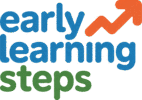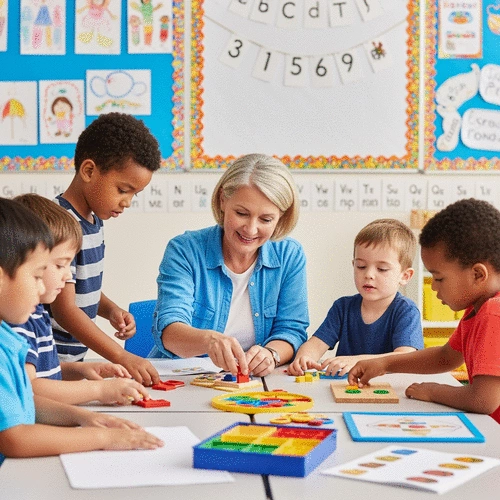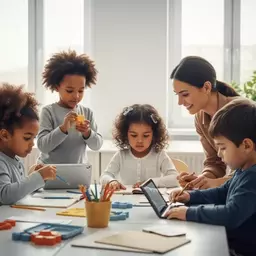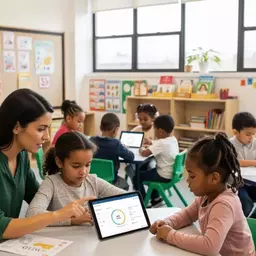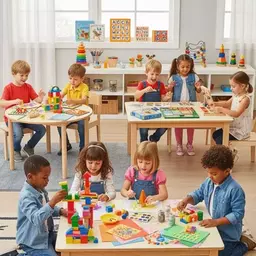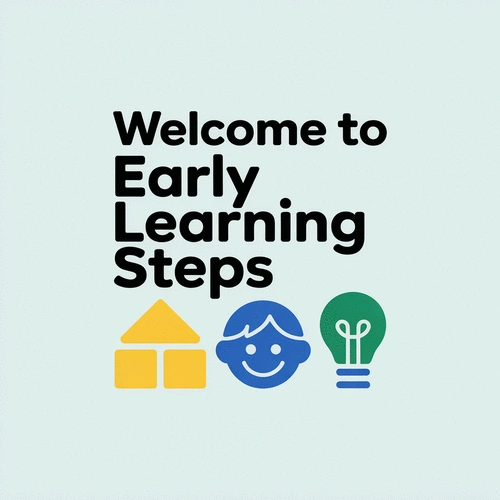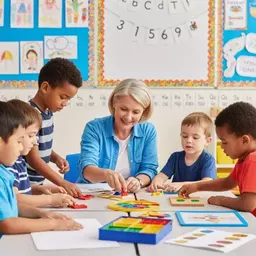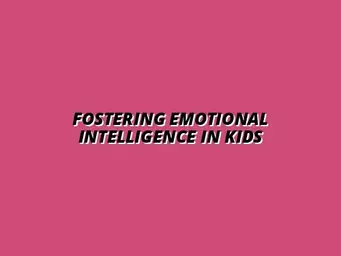In the fast-paced world of early childhood education, understanding how to seamlessly integrate play and learning can transform a child's educational experience. What if I told you that guided play not only enhances engagement but also nurtures critical skills in young learners? This approach allows children to explore while receiving the support they need to thrive.
What You Will Learn
- Guided play combines structured learning with the freedom of exploration, driving deeper engagement among children.
- Core principles of guided play include child-centered learning, teacher interaction, and promoting exploration.
- Teachers play a crucial role as facilitators, using observation and interaction to enhance learning outcomes.
- Effective strategies for guided play include creating engaging environments and using open-ended materials.
- This approach not only boosts cognitive skills but also fosters emotional intelligence and social collaboration.
Guiding Principles and Strategies for Effective Guided Play
Discover the core elements that define guided play and the practical strategies educators can use to foster a dynamic and engaging learning environment for children. To learn more about how play can impact cognitive growth, read our article on play-based learning and cognitive growth.
Defining Guided Play: Core Principles
- Child-Centered Learning: Interests drive activities.
- Teacher Interaction: Support without control.
- Exploration & Discovery: Curiosity encouraged.
Teacher's Role in Facilitating Guided Play
- Observation: Watching interactions.
- Interaction: Asking open-ended questions.
- Scaffolding: Guiding without taking over.
Strategies for Effective Guided Play
- Engaging Environments: Inspire imagination.
- Open-Ended Materials: Encourage creativity.
- Encourage Collaboration: Foster teamwork.
Key Benefits of Guided Play
- Enhances Engagement: Motivates active learning.
- Critical Thinking: Explores solutions.
- Promotes Collaboration: Improves social skills.
- Emotional Intelligence: Understands emotions.
Understanding Guided Play: A Teacher’s Perspective
As an advocate of early childhood development, I believe that guided play is a cornerstone of effective teaching. It’s more than just free play; it’s a structured approach where educators gently steer children’s activities, enriching their learning experiences. This method encourages exploration while providing the support they need to thrive. Have you ever noticed how children engage deeply when they feel both supported and free to explore? That’s the beauty of guided play!
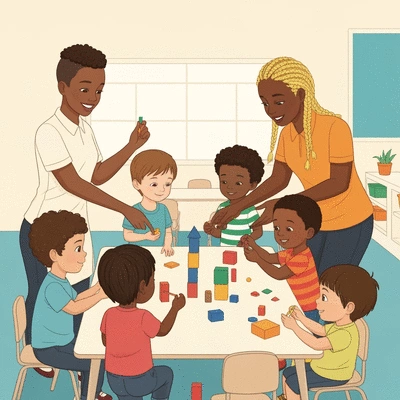
In essence, guided play combines the benefits of both play and learning, allowing children to discover concepts through hands-on experiences. This approach fosters curiosity and captivates young minds, making learning feel like a natural extension of play.
Defining Guided Play and Its Core Principles
So, what exactly is guided play? It’s an intentional method where teachers play an active role in facilitating learning through play. The core principles of guided play include:
- Child-Centered Learning: The child's interests drive the activities.
- Teacher Interaction: Educators provide support and guidance without taking control.
- Exploration and Discovery: Encouragement of curiosity and problem-solving.
These principles create a dynamic learning environment where children feel empowered to make choices while still benefiting from the educators' expertise. At Early Learning Steps, we emphasize the balance between structure and freedom because it cultivates confident learners!
The Role of Teachers in Facilitating Guided Play
Teachers have a vital role in guided play, serving as facilitators rather than directors. Our job is to observe, interact, and provide just the right amount of support. Here are some key responsibilities:
- Observation: Watching how children interact and what they are drawn to.
- Interaction: Asking open-ended questions to spark deeper thinking.
- Scaffolding: Offering hints or support that guides children’s learning without taking away their exploration.
By embracing these roles, we can make a significant impact on children’s learning pathways. How do you view your role as a teacher? Remember, it’s about empowering our young learners to take charge of their education! For more insights into effective teaching strategies, consider exploring integrating UDL in early childhood.
Teacher Strategies for Effective Guided Play
When implementing guided play, certain strategies can enhance its effectiveness. Here are some of my go-to tips:
- Create Engaging Environments: Set up spaces that inspire imagination and curiosity.
- Use Open-Ended Materials: Provide resources that can be used in multiple ways to encourage creativity.
- Encourage Collaboration: Foster teamwork by allowing children to work together on projects.
These strategies help establish a rich learning context where children can thrive. The beauty of guided play is that it supports a variety of learning styles, making it an excellent choice for diverse classrooms like the ones we advocate for at Early Learning Steps!
Quick Summary
Here's a brief recap of the key points discussed so far:
- Guided Play Definition: A structured approach where educators support children's exploration and learning through play.
- Core Principles: Emphasizes child-centered learning, teacher interaction, and encourages exploration and discovery.
- Teacher's Role: Teachers facilitate rather than direct, observing, interacting, and scaffolding children's learning experiences.
- Strategies for Implementation: Creating engaging environments, using open-ended materials, and encouraging collaboration among children.
Frequently Asked Questions About Guided Play
What is guided play?
Guided play is a structured approach to learning where educators gently steer children's activities, enriching their learning experiences through exploration while providing necessary support. It combines the benefits of both free play and structured learning.
What are the core principles of guided play?
The core principles include child-centered learning (where children's interests drive activities), teacher interaction (providing support without control), and fostering exploration and discovery (encouraging curiosity and problem-solving).
What is the teacher's role in guided play?
Teachers act as facilitators rather than directors. Their role involves observation (watching interactions), interaction (asking open-ended questions), and scaffolding (offering hints or support without taking over the exploration).
What are effective strategies for implementing guided play?
Effective strategies include creating engaging environments that inspire imagination, providing open-ended materials that encourage creativity, and fostering teamwork by encouraging children to collaborate on projects.
What are the key benefits of guided play?
Guided play enhances engagement, supports critical thinking, promotes collaboration and social skills, and fosters emotional intelligence by helping children understand their own and others' emotions.
Key Takeaways on Guided Play Strategies
As we delve into the landscape of early childhood education, it’s clear that guided play offers a transformative approach to learning. This method not only enriches cognitive development but also nurtures emotional and social skills in young learners. Reflecting on my journey with Early Learning Steps, I've seen firsthand how children thrive when play is integrated into their learning experiences. Here are some key takeaways that highlight the impact of guided play:
- Enhances engagement: Children are more motivated to learn when they are actively involved in playful activities.
- Supports critical thinking: Through guided play, children learn to ask questions and explore solutions, fostering critical thinking skills.
- Promotes collaboration: Play encourages children to work together, enhancing their social skills and ability to communicate.
- Fosters emotional intelligence: Engaging in play helps children understand their emotions and those of others, leading to better relationships.
By embracing these principles, educators can create a more dynamic and effective learning environment. Have you noticed these benefits in your own teaching? It can be incredibly rewarding to watch your students flourish through guided play!
Encouraging Educators to Embrace Playful Learning Approaches
As a passionate advocate for early childhood development, I encourage my fellow educators to embrace play as a fundamental component of their teaching strategies. Playful learning is not just a trendy approach; it's rooted in research that shows its effectiveness in cultivating curious and capable children. Here’s how you can advocate for this approach:
- Promote awareness: Share resources and success stories within your community to highlight the benefits of guided play.
- Lead by example: Implement playful learning strategies in your classroom and share your experiences with colleagues.
- Engage families: Educate parents about the value of play-based learning and how they can support these experiences at home.

When we adopt a playful learning approach, we are not just teaching; we are also nurturing lifelong learners. The more we share and advocate for these strategies, the more lives we can impact. Have you thought about how you can inspire your peers to join this movement?
Next Steps for Teachers: Implementing Guided Play in Your Classroom
Practical Tips for Getting Started with Guided Play
Starting with guided play in your classroom can feel overwhelming, but it doesn't have to be! Here are some practical tips to ease the transition:
- Begin small: Introduce one guided play activity at a time and gradually incorporate more as you gain confidence.
- Observe and listen: Pay attention to how your students engage with the activities and use their feedback to shape future lessons.
- Collaborate: Team up with colleagues to share ideas and resources, making the implementation process more enjoyable and less daunting.
Remember, the goal is to create a vibrant learning environment that encourages exploration and curiosity. Every step you take is a step toward enriching your students' educational journeys!
Joining Professional Learning Communities for Ongoing Support
Connecting with other educators who are also passionate about guided play can provide invaluable support and inspiration. Here’s how to find your community:
- Attend workshops: Look for local or online workshops focused on guided play and engage with fellow educators.
- Participate in forums: Join online forums or social media groups where educators share resources and experiences about play-based learning.
- Network regularly: Make an effort to attend conferences or meetups related to early childhood education and guided play.
These connections can lead to rich conversations and the sharing of ideas that can enhance your own teaching practice. How might you reach out to fellow educators in your area?
Reflective Practice for Continuous Improvement in Guided Play
Finally, engaging in reflective practice is crucial for improving your guided play strategies. Here are some steps you can take:
- Keep a journal: Document your observations, successes, and challenges during guided play activities.
- Set goals: Identify specific areas for improvement and set achievable goals to enhance your practice.
- Seek feedback: Encourage input from colleagues, parents, and even your students to gain different perspectives on your methods.
Reflective practice not only fosters personal growth but also enhances the learning experiences you provide for your students. What insights have you gained from your teaching experiences lately? You can further deepen your understanding of child development by exploring resources on teaching emotional intelligence in classrooms.
Recap of Key Points
Here is a quick recap of the important points discussed in the article:
- Guided Play Defined: A structured approach integrating play and learning, driven by children's interests and supported by educators.
- Teacher's Role: Facilitators who observe, interact, and scaffold children's learning without dominating the play experience.
- Effective Strategies: Create engaging environments, utilize open-ended materials, and promote collaboration among children.
- Benefits of Guided Play: Enhances engagement, supports critical thinking, fosters collaboration, and develops emotional intelligence.
- Continuous Improvement: Engage in reflective practice, set goals, and seek feedback to enhance guided play strategies.
